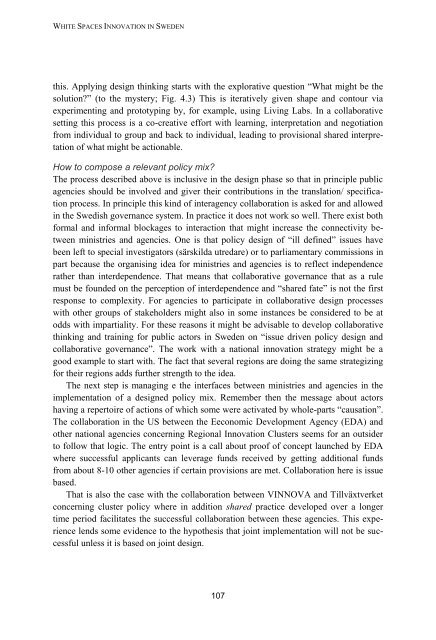White Spaces Innovation in Sweden - Innovation policy for ... - Vinnova
White Spaces Innovation in Sweden - Innovation policy for ... - Vinnova
White Spaces Innovation in Sweden - Innovation policy for ... - Vinnova
Create successful ePaper yourself
Turn your PDF publications into a flip-book with our unique Google optimized e-Paper software.
WHITE SPACES INNOVATION IN SWEDENthis. Apply<strong>in</strong>g design th<strong>in</strong>k<strong>in</strong>g starts with the explorative question “What might be thesolution?” (to the mystery; Fig. 4.3) This is iteratively given shape and contour viaexperiment<strong>in</strong>g and prototyp<strong>in</strong>g by, <strong>for</strong> example, us<strong>in</strong>g Liv<strong>in</strong>g Labs. In a collaborativesett<strong>in</strong>g this process is a co-creative ef<strong>for</strong>t with learn<strong>in</strong>g, <strong>in</strong>terpretation and negotiationfrom <strong>in</strong>dividual to group and back to <strong>in</strong>dividual, lead<strong>in</strong>g to provisional shared <strong>in</strong>terpretationof what might be actionable.How to compose a relevant <strong>policy</strong> mix?The process described above is <strong>in</strong>clusive <strong>in</strong> the design phase so that <strong>in</strong> pr<strong>in</strong>ciple publicagencies should be <strong>in</strong>volved and giver their contributions <strong>in</strong> the translation/ specificationprocess. In pr<strong>in</strong>ciple this k<strong>in</strong>d of <strong>in</strong>teragency collaboration is asked <strong>for</strong> and allowed<strong>in</strong> the Swedish governance system. In practice it does not work so well. There exist both<strong>for</strong>mal and <strong>in</strong><strong>for</strong>mal blockages to <strong>in</strong>teraction that might <strong>in</strong>crease the connectivity betweenm<strong>in</strong>istries and agencies. One is that <strong>policy</strong> design of “ill def<strong>in</strong>ed” issues havebeen left to special <strong>in</strong>vestigators (särskilda utredare) or to parliamentary commissions <strong>in</strong>part because the organis<strong>in</strong>g idea <strong>for</strong> m<strong>in</strong>istries and agencies is to reflect <strong>in</strong>dependencerather than <strong>in</strong>terdependence. That means that collaborative governance that as a rulemust be founded on the perception of <strong>in</strong>terdependence and “shared fate” is not the firstresponse to complexity. For agencies to participate <strong>in</strong> collaborative design processeswith other groups of stakeholders might also <strong>in</strong> some <strong>in</strong>stances be considered to be atodds with impartiality. For these reasons it might be advisable to develop collaborativeth<strong>in</strong>k<strong>in</strong>g and tra<strong>in</strong><strong>in</strong>g <strong>for</strong> public actors <strong>in</strong> <strong>Sweden</strong> on “issue driven <strong>policy</strong> design andcollaborative governance”. The work with a national <strong>in</strong>novation strategy might be agood example to start with. The fact that several regions are do<strong>in</strong>g the same strategiz<strong>in</strong>g<strong>for</strong> their regions adds further strength to the idea.The next step is manag<strong>in</strong>g e the <strong>in</strong>terfaces between m<strong>in</strong>istries and agencies <strong>in</strong> theimplementation of a designed <strong>policy</strong> mix. Remember then the message about actorshav<strong>in</strong>g a repertoire of actions of which some were activated by whole-parts “causation”.The collaboration <strong>in</strong> the US between the Eeconomic Development Agency (EDA) andother national agencies concern<strong>in</strong>g Regional <strong>Innovation</strong> Clusters seems <strong>for</strong> an outsiderto follow that logic. The entry po<strong>in</strong>t is a call about proof of concept launched by EDAwhere successful applicants can leverage funds received by gett<strong>in</strong>g additional fundsfrom about 8-10 other agencies if certa<strong>in</strong> provisions are met. Collaboration here is issuebased.That is also the case with the collaboration between VINNOVA and Tillväxtverketconcern<strong>in</strong>g cluster <strong>policy</strong> where <strong>in</strong> addition shared practice developed over a longertime period facilitates the successful collaboration between these agencies. This experiencelends some evidence to the hypothesis that jo<strong>in</strong>t implementation will not be successfulunless it is based on jo<strong>in</strong>t design.107
















